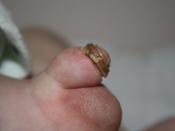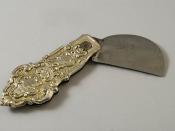Should circumcision be standard practice when boys are born here in Australia? Up until the late seventies, circumcision was routine for new born Australian boys. Now the debate rages on as to whether there are specific medical benefits to circumcision. Dr. Vijay Roach, a Sydney obstetrician, says that most fathers in the last decade want their sons circumcised; however the mother is often opposed for fear of hurting her son. It is not recommended that an obstetrician discuss with potential parents unless the parents themselves bring it up. So why did they reverse the mandate of routine circumcision? The Royal Australian College of Physicians (RACP) decided that the risk to the child far outweighed the medical benefits. However it is a key aspect of their review of child health policies currently being conducted. I believe it should be mandatory for every obstetrician to conduct an objective conversation about the pros and cons of circumcision with potential parents.
Circumcision has a rich history throughout the Jewish and Muslim religions. It is a Jewish custom that has been performed for over 3500 years, "And God spoke to Abraham saying: ...This is my covenant which you shall keep between Me and you and thy seed after you -every male child among you shall be circumcised." (Gen. 17:12). "The Covenant of Circumcision" is known as Brit (or Bris) Milah in Hebrew. For Jews, this is more than merely a medical procedure. The circumcision is a sign of the child's entry into Judaism (Naphtalia, 2003: Internet). The Jewish process differs slightly from standard in that Jewish law does not permit clamping or interventional instruments. It also does not allow anaesthetic however most ritual circumcisers will use it upon approval by the family's doctor. Nevertheless the same risks apply for both forms of the process.
Due to the introduction of the plastibell in the early nineties, the operation is not at dangerous or painful as it used to be. A plastibell is a plastic, specially designed, circumcision device is used now (Palit V, Menebhi DK, Taylor I, Young M, Elmasry Y, Shah T, 2006: Internet). Two hours prior to the procedure, a lidocaine based anaesthetic cream is rubbed onto the foreskin and then the penis is wrapped in plastic. The cream is then absorbed by the skin and the Plastibell ring is fitted between the head and the foreskin. A string is tied around the excess skin. The idea is that with the string cutting of the circulation of blood to the excess foreskin, the skin will die and fall off. If this does not occur, the excess skin is then cut off. This process is designed to minimise bleeding, the risk of infection and the risk of cutting the wrong area. The anaesthetic lasts approximately four hours and takes all up around three weeks to completely heal. Dr. Terry Russel from Queensland is the head of the Circumcision Australia Information Group. He has performed about 17000 circumcisions in the last fourteen years using this technique. He has never inflicted a major injury and says the two percent of infections that occur can be treated by antibiotics (Knox 2007:104). However complications although uncommon can arise. These include excess bleeding, infections, imprecise removal (too much or too little skin removed) and even partial amputation (Roach, in Knox 2007:104). The key issue of the debate is whether the elevated risk nullifies the medical necessity.
To say circumcision prevents AIDS or HIV would be overstating the issue but there are serious health issues revolving around sex with an uncircumcised penis. Unprotected sex or the sharing of needles are far more likely transmitters of the disease than an uncircumcised penis. Having said that the World Health Organization (WHO) and the United Nations programme (UNAIDS) have included circumcision in the process of HIV prevention. Although this is mostly concerned with third world countries in Africa and Asia, the conducted three studies that showed circumcision reduces the risk of HIV by up to 60% (Knox 2007:105).
There is also significant evidence showing that uncircumcised infants suffer five times the incidence of urinary tract infection and that uncircumcised men run a higher risk of penile cancer and giving their female partners cervical cancer (Morris, in Knoz 2007:105). There are fewer than one hundred cases of penile cancer in Australia. Significantly, almost all diagnosed are uncircumcised (Australian Bureau of Statistics 2007: Internet). In the USA and Israel where the circumcision rate is highest, the instance of penile cancer is around 1 in 100,000. Whereas in the UK and other developed countries where circumcision is less common, the instance of penile cancer is between 3 to 10 in 100,000.
The uncircumcised foreskin contains a moist inner layer of skin that is easily broken or split. This allows viruses and bacteria to enter the skin easily. The other concern is that an uncircumcised penis requires a lot more thorough cleaning. This is due skin cells and urinary residue being caught between the head of the penis and the foreskin, this would not occur in a circumcised male. According to Dr Brian Morris (cited in Knox 2007), the inner layer referred to earlier has a direct link to cervical cancer. The transmission of the Human Papilloma Virus (HPV) can occur from an infected female to her uncircumcised partner. The virus enters the inner layer of the foreskin where it strengthens. This allows the more serious strain of HPV to lead to cervical cancer the next time they have intercourse. Having said this, it must be stressed that other variables, such as the HPV, must be present, rather than an uncircumcised penis alone.
Shane Peterson, co-founder of www.circinfo.org and an anti-circumcision activist is living proof of the risks and their long term effects. Shortly after he was born in 1973, his procedure went wrong. The repercussions that followed throughout his life were incessant bullying, depression and suicide attempts. A reconstruction procedure in 1999 failed to resolve the issue. He was awarded $360.000 in court ordered damages. Shane's story raises ethical issues. Shane describes it as "an act of assault and a breach of human rights" (Knox 2007:105). Dr George Williams, a Sydney paediatrician, anti-circumcision activist and co-founder of www.circinfo.org, says circumcision is a breach of both the Australian Medical Association's Code of Ethics and the United Nations'Convention on the Right of the Child. Dr. Williams first learned of the dangers of circumcision in Canada where he received his medical training. A child there died on a gangrenous circumcision wound. The ethics debate basically the boils down to how many other decisions parents make for their children and whether this should be their choice or the child's once he is older. In the United Kingdom, a 1999 court case ruled that circumcision as a procedure was not in the baby's best interest. A doctor may not circumcise a child unless given strict permission by the child's parents. Similarly, a doctor can not prohibit circumcision. Doctors risk being sued if they do the opposite of parents request and complications arise. This has lead to a large portion of doctors in Australia refusing to perform them.
The benefits of circumcision are vast and are not just retained to cervical and penile cancer. Dr Brian Morris, a professor of Molecular Medical Sciences and the University of Sydney, he is leading voice of the pro-circumcision movement in Australia and the founder of the web site www.circinfo.net. He found that the risk of syphilis is up to nine times higher in uncircumcised males. However he agrees that condoms, not circumcision are the best prevention of STDs or STIs. He also performed a study in 1989 in Sydney found that women were more three times likely to reach orgasm when having sex with a circumcised man as opposed to an uncircumcised man. They also said that they preferred performing fellatio on circumcised partners. All in all there is no denying that circumcised men a more likely to be cleaner than an uncircumcised male, purely because it is easier to clean a circumcised penis.
According to the National Centre for Health Statistics (2007:Internet) in the United States, almost 65% of white and black males are circumcised. It is a routine procedure and parents must request for it not to be performed. Why then here in Australia did we change our minds in the seventies? Some may say that because the US has one of the highest rates of HIV, they require it as a preventative measure, like those in Africa.
The review by RACP will release its findings from its review later this year. Surely with all the evidence of the benefits and the low number of complications these days, we in Australia should at least make it compulsory for doctors to offer information about the procedure.
BibiographyAustralian Bureau of Statistics, 2007, National Health Statistics, (online), available from: http://www.ausstats.abs.gov.au/ausstats/subscriber.nsf/0/A58E031838C37F81CA257141000F1AAF/$File/4363055001_2004-05.pdf, [4 September 2007]Benefits of Circumcision, (online), 2006, available from: www.circinfo.net, [21 June 2007]Circumcision in Australia, (online), 2007, available from: www.circinfo.org, [21 June 2007]Knox, Malcolm, 2007, "Foreskin and Against", Men's Health, July, Pages 101-105Naphtalia, 2003, Understanding Why Jews Do Circumcise (online), available from: http://www.epinions.com/content_1497145476, [21 June 2007]National Center for Health Statistices, 2007, Trends in Circumcision among newborns, (online), available from: http://www.cdc.gov/nchs/products/pubs/pubd/hestats/circumcisions/circumcisions.htm, [4 September 2007]Palit V, Menebhi DK, Taylor I, Young M, Elmasry Y, Shah T, 2006, Hollister Plastibell, (online), available from: http://www.circlist.com/instrstechs/plastibell.html, [4 September 2007]


